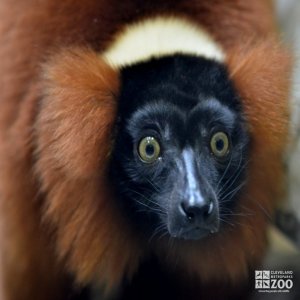Red Ruffed Lemur
[Varecia rubra]

Red ruffed lemurs have a head and body length of about 20 inches. Their tail length is about 24 inches and their weight is just under 8 pounds. Most of the dorsal body coat is a deep, rusty red. There is a white patch on the neck, and small patches of white may appear on the heels, digits and muzzle. The extremities, tail, insides of the limbs, forehead, and crown (excluding the ears) are black. Some variations to this coloration may exist. Females have 3 pairs of mammae.
Location: Primate & Cat
Share:
Range
The range of the red-ruffed lemur is Northeastern Madagascar.
Habitat
Red-ruffed lemurs inhabit rain forests.
Conservation Status
EndangeredPrimary Threats
Human Wildlife Coexistence, Climate ChangeGestation
90 to 102 days
Litter
Usually two, sometimes one or three
Behavior
Red ruffed lemurs are arboreal forest dwellers. Progression is by walking or running on larger branches, and leaping from tree to tree. Locomotion is more labored and cautious than with other Lemur species. They are crepuscular, being most active from 5:00 pm to 7:00 pm, when their peculiar calls are commonly heard. Vocalizations include an intense roar of alarm, and a powerful, plaintive call for territorial expression. Group sizes can range from 2 to 16. All group members use a common home range, and aggression has been noted between groups. Females form the core of the group, and defend the territory. The weakest social bonds are between males. Grouping patterns change seasonally. Females group in larger numbers during the wet summer, and are more dispersed during the drier winter.
Reproduction
Mating season for red ruffed lemurs begins in May, with most matings being in June and July. The young are usually born in September and October. Infants are at first left in the nest, rather than being carried about by their mothers. Later they are carried in the mother's mouth, and begin to follow the mother by about 3 weeks of age. They are fully mobile at about 7 weeks. Weaning is at around 135 days. Females may become pregnant at 20 months.
Wild Diet
Fruit, vegetable matter, leaves, sap and nectar
Zoo Diet
Leaf-eater diet, monkey chow, fruits, vegetables
